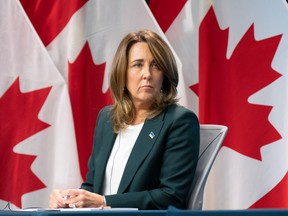Rogers warns rates may not return to low levels people were used to before pandemic

Rising longer-term borrowing costs are adding to debt service costs for businesses and individuals, Rogers said, leaving “less wiggle room” for the financial system in the event of a shock, like another sharp tightening of financial conditions.
“As a small, open economy, Canada likely wouldn’t be immune if severe global stress were to re-emerge and persist.”
Some Canadians are feeling pressured as they contend with both higher inflation and higher interest rates, she said, and are struggling to deal with existing debt. With 40 per cent of mortgage holders already seeing their shorter-duration mortgages renew at higher interest rates, Rogers said officials are watching how households adjust.
“By the end of 2026, virtually all remaining mortgage holders will go through a renewal cycle and, depending on the path for interest rates, may face significantly higher payments.”
While Rogers made clear her comments weren’t meant to be predictive in terms of the path for the Bank of Canada’s overnight rate, the speech also adds to evidence policymakers increasingly see borrowing costs as less restrictive. The bank held its key rate at five per cent for the second straight meeting in October, citing mounting evidence of a slowing economy despite increased inflation risks.
Speaking to lawmakers last week, governor Tiff Macklem said the neutral rate — the theoretical level of interest rates that is neither restrictive nor stimulative — was probably drifting higher, and he admitted he wasn’t comfortable with the bank’s decision to leave the range for the neutral rate between two per cent and three per cent in their annual review earlier this year.
Bloomberg.com
Share This:
Next Article




